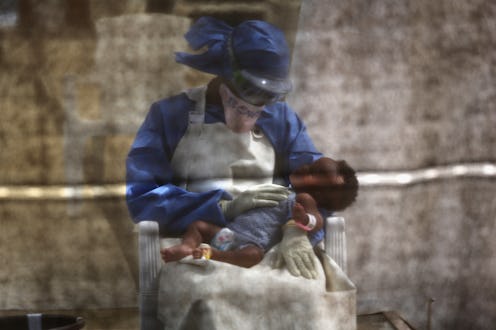News
Ebola, By The Numbers
On Saturday, Liberian officials declared that the country's horrific 2014 Ebola outbreak was finally over, bringing the nearly 14-month epidemic to a close. According to World Health Organization epidemiologist Luke Bawo, a total of 42 days — the maximum number of viral incubation days during which the disease could take hold and trigger symptoms — had passed without incident (and since the burial of the last Ebola victim) in the West African country, leading health experts to make the announcement. The news was promising, but a closer look at the terrifying outbreak statistics proves just how bad things were and how close the country and nearby regions, which are still suffering, have come to absolute devastation.
On Saturday morning, Liberian President Ellen Johnson Sirleaf held a news conference to discuss the aftermath and asked for a moment of silence for those who had died, cautioning officials to remain vigilant. "Let us celebrate, but stay mindful," she added.
As CDC and WHO experts begin to piece together the fragments leftover from the deadly outbreak, the spotlight has now been turned on neighboring Sierra Leone and Guinea, which are still in the epidemic's clutches.
"We are very much concerned about Guinea and Sierra Leone," said Liberian Health official Tolbert Nyenswah, indicating that leaders were willing to do whatever it takes to bring down the epidemic in full.
According to WHO situation reports (SITREPS) from the last 14 months, the massive Ebola outbreak has taken the lives of over 11,000 individuals throughout Western Africa, including almost 5,000 in Liberia prior to Saturday's announcement. In total, it has been estimated that more than 26,000 have been affected by the disease since initial outbreak reports in March 2014. By late last year, health officials had declared the epidemic the deadliest one since the virus' discovery in 1976, indicating that it had killed over five times as many victims as all previous epidemics combined.
Of the outbreak's quarantined victims, WHO reports confirm that some 4,000 have been children younger than 14. Over the first year, however, the majority of cases (over 11,000) stemmed from civilians ages 15 to 44 — many of whom contracted the disease despite officials cordoning off "infected" regions of the country to outsiders.
"[Ebola] is not easily transmitted," suggested Ian Lipkin, the John Snow Professor of Epidemiology at Columbia University's Mailman School of Public Health in New York City, in an interview with National Geographic in March 2014, pointing to traditional burial methods as a possible pinpoint for the initial spread of the virus. Lipkin continued:
There's this ritual behavior [in some areas, where] they wash bodies by hand to prepare for burial—a loving way of sending the spirit into the next world. This kind of behavior brings people into very close contact with body fluids that are infected, and that's how people become infected.
At its onset, the crisis easily began stacking body counts at an alarming rate — at its high point, anywhere from 500 to 600 new cases were being reported in Liberia and Sierra Leone every week with a mortality rate of around 70 percent. Health officials were forced back to the drawing board. By July, WHO officials had finally reached out to the disease-stricken Liberia to provide masses of new protective equipment and fresh medical supplies to aid workers, many of whom had been shunned by their families and friends.
"The people have driven us away [and] we are no longer accepted by our families," one regional worker, Matthew Kruah, told Mashable's Kieran Kesner in a stunning eyewitness report last October. "Because of this sickness, they have totally disowned us."
In a commencement speech last week at Indiana University's School of Medicine, Dr. Kent Brantly, who worked in Ebola-ravaged Liberia during the height of the crisis and was subsequently quarantined with the disease at Emory University Hospital in Atlanta before being subjected to an experimental procedure which ultimately saved him, told graduates that, of the 20 patients he treated in a three week span, only one survived. Still, he cautioned, the numbers were only one part of the equation.
"Losing so many patients certainly was difficult, but it didn't make me feel like a failure as a physician," said Brantly. "I learned that there was so much more to being a physician than curing illness — the most important thing we do is enter into the suffering of others."
As the war to stem Ebola in Sierra Leone and Guinea rages on, the broken families are slowly beginning to mend — but the journey back will take time and understanding of the ongoing hidden threat.
Iris Martor, a nurse and nonprofit program director in the devastated West Point slums of Monrovia, told The New York Times, "If we forget ourselves and go back to the careless way of life, there could be another outbreak."
Images: Getty Images (3)
